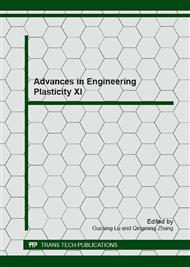p.342
p.346
p.353
p.357
p.361
p.365
p.369
p.373
p.377
A Study on the Collapse Characteristics of CFRP Circular Member According to Collision Energy Conditions
Abstract:
Vehicle structure must be lightweight in order to improve fuel-efficiency and reducing exhaust fumes. The most important goals in designing automobile are safety and environment-friendliness. There are lots of studies on the crushing absorption energy of a structural members in automobile. The crashworthy behavior of circular composite material tubes subjected to axial compression under same conditions is reported in this paper. Energy absorption of CFRP circular member is affected by lamination conditions. Test was executed in order to compare the results to the energy absorption and collapse shape.
Info:
Periodical:
Pages:
361-364
Citation:
Online since:
January 2013
Authors:
Price:
Сopyright:
© 2013 Trans Tech Publications Ltd. All Rights Reserved
Share:
Citation:


